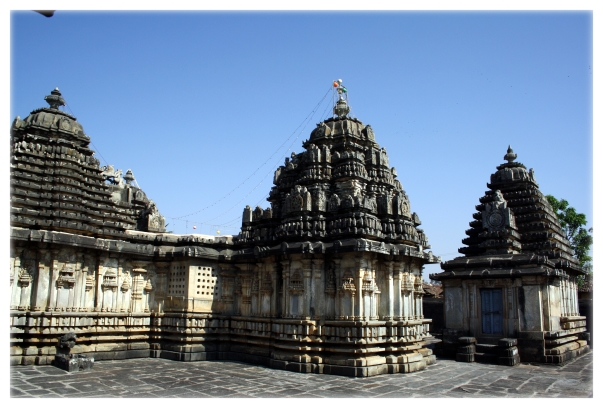Doddagaddavalli

Doddagaddavalli Village
Doddagaddavalli Village
A
bout 16km (10 miles) from Hassan on the way to Belur is Doddagaddavalli, a village popular for the 12th century Lakshmi Devi temple. Thanks to the presence of mega-magnets like Belur and Halebeedu, in the region Doddagaddavalli is yet to find a prominent place in the tourist itinerary.That's good news for those who are looking for a pleasant deviation from the crowded touristy attractions. To its stature and importance Doddagaddavalli is far unrepresented in the tourism destinations of Karnataka.
Doddagaddavalli is set in a scenic rural environment. According to the legends the temple was built in 1114 A.D. by a merchant called Kallahana Rahuta, a merchant or high officer in the Hoysala court. To be precise this temple was constructed under the patronage of Rahuta's wife Sahaja Devi.
Lakshmidevi temple of Doddagaddavalli is noteworthy and interesting for many reasons.
First of all its settings. The temple is built on the side of a large pond. In fact as you reach Doddagaddavalli, the sprawling lake appears on your left much before you enter the village proper. On the far end of the shore you can spot the pointing roofs of the shrines. A series of long granite steps along the outer wall of the temple compound separates the pond from the temple compound.
The inscription plank inside the Lakshmidevi Temple in Doddadaddahalli
This is one of the earliest Hoysala style temples built with its peculiar architecture. Though it is one of the oldest temples in Karnataka, the Lakshmidevi temple is in an amazingly well preserved condition. Many of the Hoysala temple built much later than this temple are in a dilapidated condition or even vanished over time. The temple of Doddagaddavalli is amazingly intact.
The main shrines are located within a high walled compound. At the four corners of the walls are four smaller shrines.
The main temple is located at the center of the compound. In fact this temple has four shrines facing each other and sharing the common hall within the temple. In other words there is one shrine each facing the cardinal directions, a very peculiar composition of a Hindu temple.
Image of Nagakanyâ, the snake lady, at the doorjamb of Kali sanctorum.
The shrines contain both Vaishnava and Shaiva deities, namely Lakshmi, Siva, Vishnu and Kali. While the shrines of Lakshmi , Vishnu and Shiva shares a common Mantapa ( square hall) , the shrine of Kali is connected to the Mantapa via an oblong hall. The two entrances to the temple are located in this oblong hall.
The ceiling of the central hall are extraordinary carved. Thanks to the closed nature of the temple architecture, you need some torch to see the details. If you are lucky enough, the caretaker would have a battery operated torch with him. As a last resort use the light from your mobile phone , though it would be grossly inadequate to illuminate the ceiling. It's not a bad idea to bring along a small battery operated torch.
At the eight cardinal quarters of the ceilings are carved with the guardian deities of the respective directions. They are portrayed in bold circular carvings complete with their vahana (vehicle) and consorts. Baring a few , all of these images are in an excellent condition of preservation.
Indra, one of the 8 Astâdikpalakâs. According to Vâstu - India being the guardian deity of the north - this image is carved in the ceiling of the northern portion of the central hall common to the three shrines.
Being at the top and inside the temple (away from vandalism and weathering by natural elements) , this gives a good idea of the original finish and intricacy of the Hoysala sculptures.
Indra is portrayed as riding his vehicle, the four tusked white elephant called Airavat. Also seen on the elephant is Indra’s consort Indrani.
A brief descriptions about the lords of the directions are given below. Apart from the eight quarters, the central ceiling of the mantapa contains the image of the dancing Siva.
Indra is the load of east. He accompanied by his consort rides the white elephant called Airavat. You can even spot Indra holding his weapon Vajra
Agni or the Lord of Fire rules the southeast direction. His vehicle is a one horned ram and holds the weapon sakti.
Yama, the Lord of the Death is also the lord of south direction. He rides a buffalo and holds a staff ( danda) as his weapon.
Nirruta is the goddess of southwest. Her vehicle is a human form.
Varuna , the lord of seas rules the west direction. He holds a noose (pasa) as his weapon and rides on a crocodile .
Vayu, the wind , rules northwest. Vayu rides on an antelope and holds a flag mast.
Kubera in the north is mounted on a horse.
Isana , an aspect of lord Siva is the ruler of the northeast direction. His mount is bull and holds a trident as his weapon.
The main shrine faces east with tall image of Lakshmi enshrined in the sanctorum. The image is usually decorated with garlands, especially during the auspicious seasons. Lakshmi holds a conch in the upper right hand; a chakra (discuss weapon) in the upper left ; a rosary in the lower right ; and a mace in the lower left hand. On either sides of Lakshmi are the female attendants.
Opposite to the Lakshmi shrine is the Shiva shrine. The idol here is a Linga in the form of Boothanatha Linga. Right next to the Linga are images of Ganapati and Subrahmaniya.
Between the Shiva and Lakshmi is the shrine of Vishnu , facing the south along the axis of the temple.
Two Betal human sized images (living skeletons) stand as the guardians on either side of the Kali shrine. Note the protruding tongue, the chopped head in the left hand and the machete in the right hand.
The Kali shrine is located a bit off at the longer end of the hall , facing north. Images of two giant Betāls ( living skeletons) stand guard on either side of the Kali shrine. These Betāl images are absolutely unique to the temple of Doddagaddavalli. Though it is not unusual to spot such demon images in other Hoysala temple, the ones in Lakshmidevi temple of Doddagadduvalli is carved in a mysterious style that evokes a cult like outlook to the shrine.
The Betal images are naked and life-sized. It's stooping posture with the protruding tongue adds to the eerie. A beheaded head dangles from its left hand.
The door lintel of the Kali shrine is carved with a series of ferocious looking faces. At the base of the doorjambs are the images of Vishakanya and Nagakanya. Both wears footwear. Nagakaniya holds a snake around her body like an arch.
The tall Kali image enshrined in the sanctorum is with eight arms.
Rows of lathe turned pillars, typical of Hoysala architecture, supports the ceiling. The outside walls of the temple is devoid of the rows of sculptures common to the Hoysala temples. The only exceptions are probably the Dwarapalakas ( doorkeeper deities) on either side of the door to the temple. Instead the whole outer wall is richly decorated with pilasters in the form of miniature pyramids.
All the four towers of the main temple is of the stepped pyramid style, with the pointed Kalasa and the Hoysala emblem ( of Sala fighting the lion) at the top. But one of these four towers is with elaborate carvings. This is the tower over the main shrine, that is the Lakshmi Devi shrine.
If you are familiar with other Hoysala temples ( like the one in Somnathpur, Belur or Halebeedu) it is easy to notice the absence of the star like base, that is characteristic of Hoysala temples. In other words the temple doesn't stand on an elevated fluted platform that duels as the Pradakshina ( circumambulating ) path too.
As mentioned earlier, the temple has two entrances along the same axis, one facing west while the other facing east. The main one is the east facing with two beautifully carved Dwarapalakas on wither side. Further down are the images of elephants on either side of the doorways.
On the western side of the temple is another standalone shrine. This is dedicated to Bhairava, an aspect of Shiva. The Bhairava shrine too have its stepped pyramidal tower with Kalasa at top and the Hoysala crest of the Sala slaying the lion.
In the court , between the main temple and the Bhairava temple is a stone plank with inscriptions and images carved on it. This temple compound contains about six such inscriptions explaining the construction and patronage. In all probability many people would have contributed its construction at various points in time and hence many such planks installed at various points.
Another interesting feature is the cubical drain outlets from each shrines. They are executed as the head of mythical beasts with open mouth that acts as the drain chanal. Right beneath where the water falls on the ground is rectangular urn, again carved out of stone.
The main temple with its four towers, the tower Bhairava temple and the four towers of the corner shrines make it a total of nine towers. And all the nine towers are intact complete with their Kalasa at the pinnacle and the Hoysala crest. This is something rare to see in any surviving Hoysala temples.
The main entrance to the temple compound is through a gateway on its eastern wall. A porch with the lathe turned pillars makes this entrance looks grand.
All around the temple is a lawn maintained by the archeology department. Around the lawn is the fence withe a gate at a corner. Bordering the temple compound are the village houses. If the gate is kept locked, ask for help in the village to trace someone with the key. The caretaker and the priest lives in the village who can open the temple for visitors. It is very likely that the gates are kept locked as visitors to Doddagaddahalli and few and that too occasional.
The western gate on the compound wall opens to the pond beyond it. This side is marked with a ghat ( steps) and the ruins of many mantapas (pavilions) facing the pond. This gate is usually locked. However you can access the pond and the steps by going around the outside of the compound wall through the narrow village allies.

Lakshmidevi temple at Doddagadavalli
Lakshmidevi temple at Doddagadavalli
Soapstone sculptures
The beauty of the Hoysala templs , particularly its intricate carvings owes a lot to one material - Soapstone. Unlike granite, sandstone and marble used in the construction of most of India's ancient monuments, soapstone is softer with some peculiar properties that set it apar from the former materials. To give you an idea , the softer version of the soapstone can be carved even with your finger nail.
